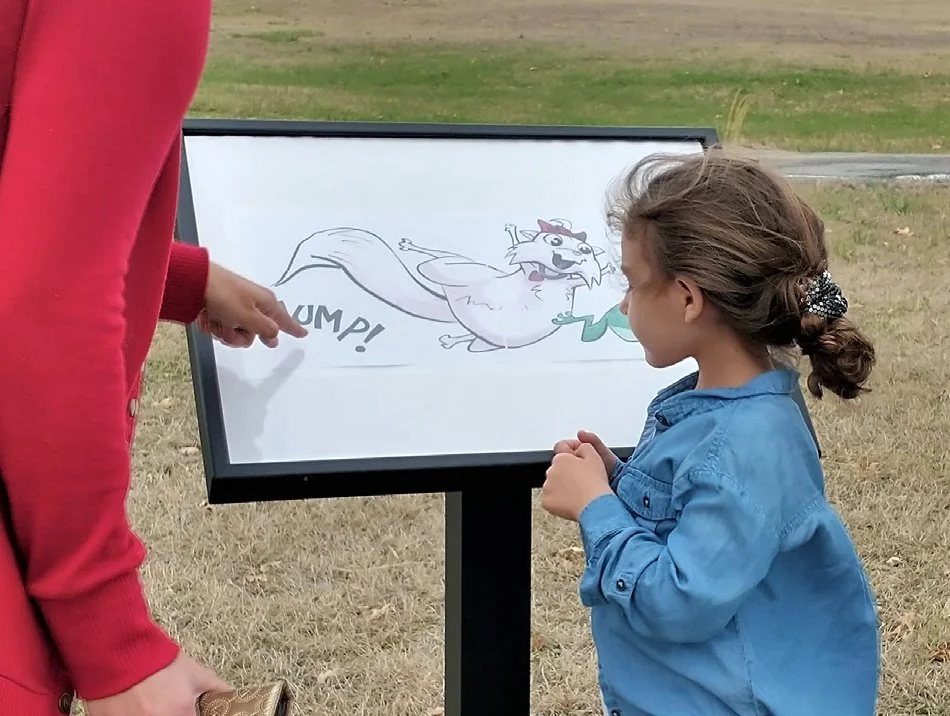What makes a great StoryWalk?
5 Elements for a successful reading display
StoryWalks®, Storybook Walks™, story strolls, story trails, and book walks are all creative approaches to storytelling that invite children to move from page to page of a book displayed along a path, hallway, or fence. The original StoryWalk® Project—developed by Anne Ferguson in collaboration with the Kellogg-Hubbard Library—was groundbreaking in combining physical activity with literacy. These early StoryWalks® were typically placed outdoors in permanent display cases and hosted by libraries, museums, and parks.
At StorybookWalk.com, we believe that the magic of a walking book experience can happen just about anywhere—with minimal cost and maximum creativity. That’s why we’ve developed a variety of flexible, accessible ways to set up walks both indoors and outdoors. Whether you're using laminated pages or crafting your own displays, we’re here to help. In our experience, five key elements make a reading walk truly successful.
5 Elements for a successful Storywalk:
1. A good book
This is the most important aspect of any Storywalk. A good book fits its audience. It is for the appropriate age group, fun, and easy to read. In addition, it has beautiful illustrations which encourage children to find out more. In most cases due to copyright laws, you will need to get permission from the author or publisher to do a storybook walk. Libraries are allowed some exemptions.
One of the gorgeous watercolor illustrations from the book The Acorn and the Oak from Rhonda Accardo and Jessica Waterstadt.
2. The perfect location
A Storywalk does not need to be outside. There are many great indoor walks. The main thing is that it is at a location which fits the content of the book and is placed in a way that children can read it. A story about taking care of your library book would work great on the windows of the library while a story about the beauty of nature would be better along a path outdoors or hung up along a fence.
School is More Than a Building from Kelley Donner on the windows of a school library.
3. Great prompts
Prompts are questions which are displayed at the bottom of a spread (double-sided page) which encourage children to move, speak, or react in some way. There are literacy, activity, and discussion prompts. A prompt may ask a child to make a silly face, jump, or even run back and forth between the pages.
4. An effective display
If your institution has the funds, a permanent display is a great way to hang up a walk. Pannier Graphics, for example, has some wonderful Storywalk frames at affordable prices. However, sometimes doing something a bit different can also be really fun and exciting. Not only is it possible to hang up a Storywalk on a wall or fence, there are also options for “no-hang” walks. These alterative walks are great for a quick walk with little preparation. A Storywalk does not need to break the bank.
A child looking at a book on a Storywalk frame from Pannier Graphics.
5. A budget
If you are hesitating to do your first walk because you think you do not have the funds, then look no further. The new DIY Storybook Walk Editions created by A Little Donnerwetter Books are fantastic for creating walks on a budget. This is a version of a book which makes creating a storybook walk much easier. The back of each double-sided page, or spread, is white, and prompts have already been added. All you need to do is tear out the pages and cut along the dotted lines, match up the spreads, laminate, and display as desired. A Little Donnerwetter Books currently has a few editions available and is busy adding new authors to their collection. In addition, there are also Ready-to-Use Storybook Walk Editions which come laminated and ready to hang. You can now do a complete storybook walk for under $50.
Outdoor literacy displays are a fabulous way to encourage children to read. They are perfect for libraries, schools, public parks, and anywhere where children gather. If you would like to learn more about how to do your next walk, check out the information on StorybookWalk.com or order our new book, “How to Create a Storybook Walk: simple, creative, and affordable ways to make your first walk a success” (available mid July, 2024) for only $11.99.
Isn’t it time that you created your first storybook walk?
-May 28, 2024
StoryWalk® is a registered service mark owned by Anne Ferguson of Montpelier, VT and developed in collaboration with the Kellogg-Hubbard Library. It is used here for informational and comparative purposes only.







